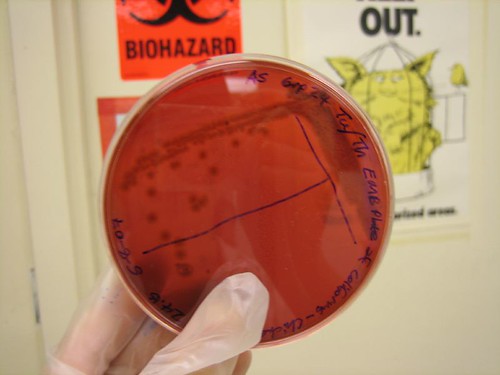
so we had a food and water contamination experiment a couple of weeks ago in class where we had to collect food and water sample, then try and find out what was growing on them. more specifically, we were looking for fecal contamination. remember those alfalfa and spinach scares?
realizing i could do homework and cook at the same time, i got a water sample from rinsing out the styrofoam package for the chicken into an old sterilized jam jar and brought that to lab the next day. after incubating a sample for a few days at around body temp and adding some prepared reagents for a diagnostic test (Colilert), the sample was shown to contain E.coli. then i streaked it out onto an EMB agar (not as yummy as almond flavored agar-agar) plate and grew it on and tried to identify just one of the isolated colonies (there can be a bunch of different bacteria in a sample). in case you're curious, it's Serratia liquefaciens.
anyhow, long story short--cook your food thoroughly! oh and no need to worry about drinking fountains.. all samples from there tested negative. however..someone's kitty water bowl, Mission Bay, and Los Penasquitos creek are teeming with contamination. oh, and if it hasn't killed you yet, don't worry. no need to rush out and buy that antibacterial Palmolive stuff (which actually works. maybe i'll take a picture of that at work. still not going to make me use it though).
here's an excerpt from my lab report to explain what's going on:
The largest source of potentially pathogenic microorganisms in water is animal feces. Some enteric diseases can be spread from infected to healthy persons through fecally contaminated water supplies. Typhoid fever and cholera are examples of enteric diseases that can be caused by bacteria in water. (1)
A common test for water safety depends on the presence of coliform (any organism that is like E. coli, an enteric bacteria) bacteria in a sample. E. coli, an enteric coliform, is the more reliable sewage indicator since it is not normally present in soil, while E. aerogenes has been isolated from soil and grains. In addition, E. coli lives longer in water than other intestinal pathogens, therefore if no E.coli are present, one can assume that there are no other intestinal pathogens present. (2, 4)... Coliform bacteria have the key characteristics of being small gram-negative rods, non-spore forming, lactose fermentation in the presence of bile with acid and gas production, and production of a green metallic sheen on eosin-methylene-blue (EMB) agar. EMB agar is a selective medium whose dyes usually inhibit the growth of gram-positive bacteria. EMB agar is also a differential medium because it differentiates bacteria that ferment lactose with the production of small to copious amounts of acid. That green metallic sheen on EMB is formed by the excretion of so much acid during acid fermentation that the dyes precipitate in and on the surface of the coliform colonies. (1, 4)

No comments:
Post a Comment